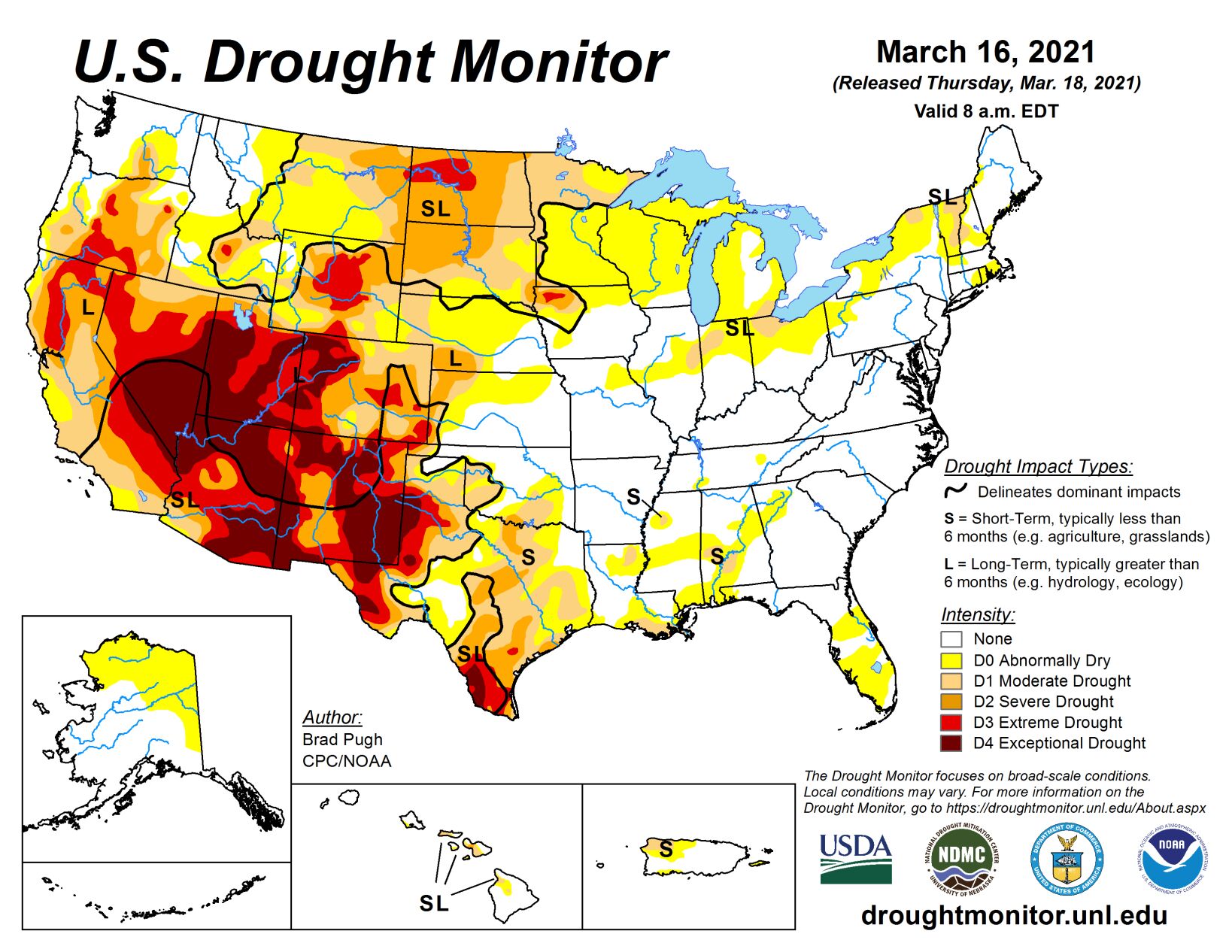Low pressure system brings widespread precipitation; Denver receives 4th largest snowfall on record

A vigorous and slow-moving area of mid-level low pressure tracked from the Four Corners region to the Central Great Plains from March 13 to 15. Widespread precipitation (rain and snow totaling 2 to 6 inches, liquid equivalent) fell across the Central Rockies, Central Great Plains, and Lower Missouri River Basin. Snowfall amounts ranged from 2 to 4 feet from Colorado north to Wyoming.
However, across North Dakota, dry weather continued. As a low pressure system tracked eastward, rainfall (locally more than 2 inches) overspread the Ohio and Tennessee Valleys along with parts of the Southeast on March 14 and 15. Mostly dry weather prevailed along the East Coast from March 9 to 15. During this 7-day period, below normal precipitation was observed throughout much of the Pacific Northwest while precipitation amounts exceeded 2 inches (liquid equivalent) for the Sierra Nevada Mountains and coastal ranges of California. A low pressure system and trailing front resulted in heavy rainfall and flooding across parts of the Hawaiian Islands during early March.
High Plains
A strong and slow-moving low pressure system brought widespread heavy precipitation (more than 2 inches, liquid equivalent) to northeast Colorado, southeast Wyoming, southwest South Dakota, northern Kansas, and much of Nebraska. Denver, Colorado, received 27.1 inches of snowfall on March 13 and 14, making it the 4th largest snowfall on record. According to the storm summary from the Weather Prediction Center, other notable snowfall amounts included: 42” near Buckhorn Mountain, Colorado, 27” near Hot Springs, South Dakota, and 19” near Gering, Nebraska. The highest snowfall amount reported from this storm was 52.5” at Windy Peak, Wyoming. The heavy snowfall brought snow water content close to average for mid-March across most of Colorado and Wyoming. This recent heavy precipitation also eliminated precipitation deficits and resulted in precipitation surpluses for the past 90 days for much of the central Plains. Therefore, a broad 1-category improvement was made for areas that received 1 inch or more of precipitation. Based on SPI values at various time scales, small areas of 2-category improvements were justified for the central Great Plains west to the central Rockies. Please note that the drought impact type was changed from SL (short and long-term) to L (long-term) drought only where the heaviest precipitation occurred, but where long-term indicators such as SPI support a continuation of D1+ long-term drought.
Based on 120-day SPI values, a 1-category improvement was made to parts of southwest Wyoming and bordering areas of southeast Idaho and northeast Utah. Farther to the north, the northern third of South Dakota and North Dakota missed out on the drought relief. During the past two weeks, widespread 1 to 2-category degradations were made and only slight changes were necessary this week. However, based on soil moisture below the 5th percentile and SPI values, D3 (extreme) drought was introduced to parts of North Dakota. If below normal precipitation persists later into the spring when temperatures warm, rapid intensification of drought conditions may occur.
South
As an intense mid-level low pressure system crossed the Four Corners Region, an early season severe weather outbreak occurred across the Texas Panhandle on March 13. According to the Storm Prediction Center, more than a dozen tornado reports were tallied. Along with the severe weather, locally more than 1 inch of rainfall was observed across the Texas Panhandle, resulting in drought improvement. This 1-category improvement extended east to parts of southwest Oklahoma where Oklahoma Mesonet gauges recorded 1 to 2.5 inches of rainfall this past week. Elsewhere across the southern Plains, western Gulf Coast, and lower Mississippi Valley, mostly dry weather prevailed along with above normal temperatures and periods of increased winds. Based on short-term indicators, abnormal dryness (D0) and drought (D1-D3) were expanded in coverage across south-central Oklahoma and Texas. Wheat is entering the critical hollow stem stage across south-central Oklahoma. The northeast quarter of Louisiana has received less than 4 inches of precipitation during the past 60 days which prompted a slight increase in the coverage of short-term moderate drought (D1). An increase in the coverage of D0 was made across parts of Louisiana and Mississippi, due to increasing short-term precipitation deficits along with soil moisture and 28-day streamflows below the 30th percentile.
Midwest
A major storm brought widespread heavy precipitation (1 to 3 inches, liquid equivalent) to western Iowa and Missouri. This recent precipitation resulted in a 1-category improvement for areas that received more than 1.5 inches of precipitation. A slight eastward expansion of abnormal dryness (D0) across northeast Missouri, which merged with the ongoing D0 in west-central Illinois, was supported by short-term SPI values and decreasing 28-day average streamflows. The largest 90-day precipitation deficits (2 to 4 inches) for this region exist across the northern half of Indiana and Ohio along with parts of Michigan. Based on 60 to 90 day SPIs, along with low soil moisture (below the 30th percentile), abnormal dryness (D0) was expanded to include more of eastern Indiana and bordering areas of Ohio with a slight expansion of short-term moderate drought (D1) across northern Ohio. Conditions improve farther south over Ohio where a slight reduction in abnormal dryness was warranted.
West
Below normal precipitation prevailed across the Pacific Northwest during the past week. Recent dryness during the past 30 days and below normal 28-day average streamflows supported a northward expansion of abnormal dryness (D0) across eastern Washington. Near to above normal precipitation was generally observed throughout California, the Great Basin, and Desert Southwest during early to mid-March. As of March 16, snow water content is running 60 to 75 percent of average across the Sierra Nevada Mountains. No changes were made this week to much of the moderate (D1) to exceptional (D4) drought areas across the West.



